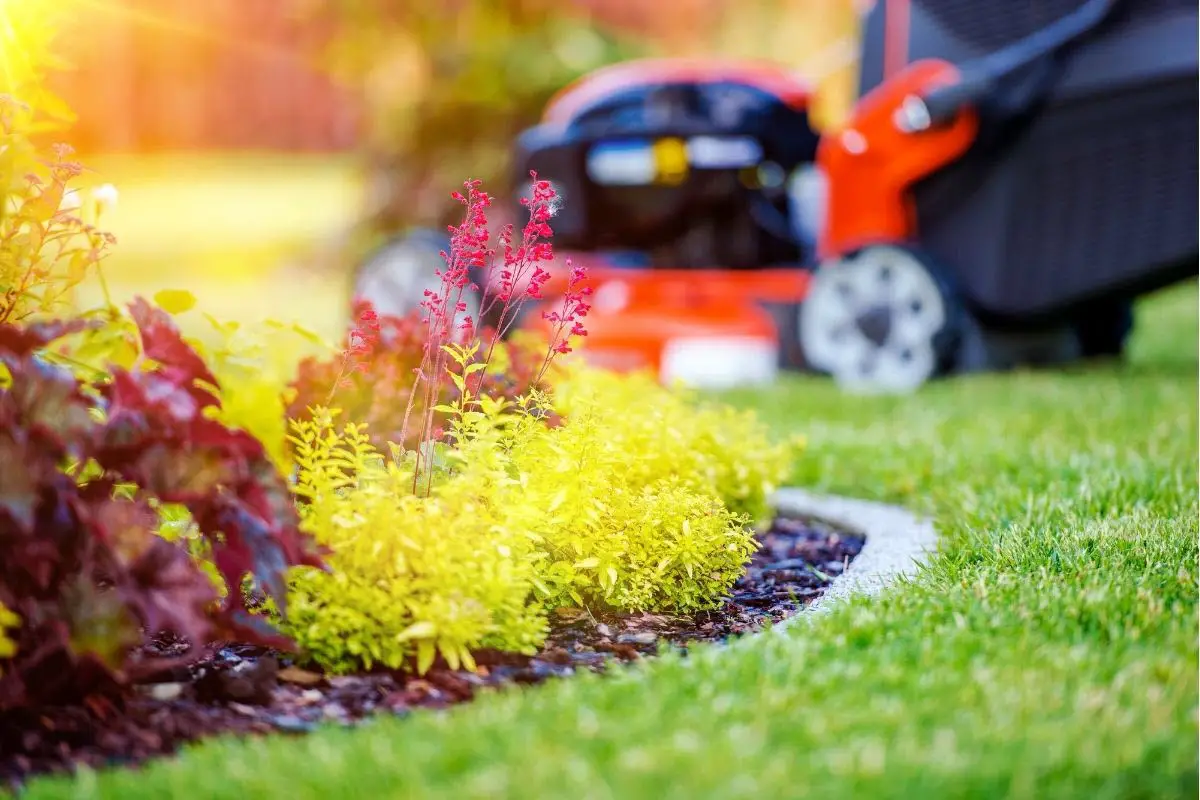Eco-Friendly Alternatives To Grass Lawns: From Clover To Artificial Turf
I love when an ‘ethical’ consumption decision is also a major life improvement. Finding eco-friendly alternatives to grass lawns has definitely been a huge win for me. Mowing the lawn is one of those jobs that I passionately dislike and always find ways to procrastinate!
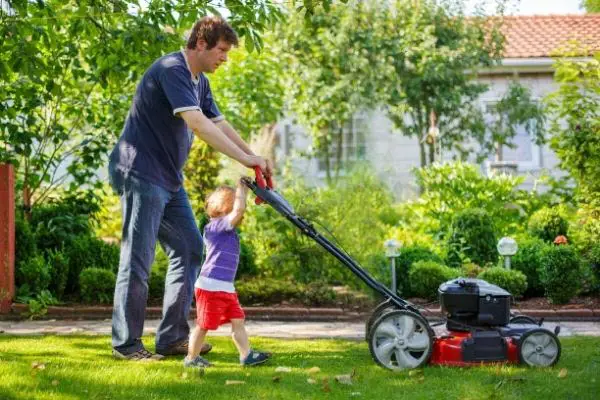
The traditional grass lawn might be a hallmark of the American Dream but it’s certainly not doing the environment any favors.
Ethical consumption makes a difference towards creating a more sustainable world. Yet some of the most immediate impacts we can make to the environment happen in our own backyards.
Replacing your existing grass with another ground cover could make your lawn more sustainable, water-conscious, and biodiverse. When I add to the equation that it saves me from regular mowing jobs, it really feels like I just won the lottery!
Of course, ripping up AND replanting your entire lawn is no easy task. So we’ve put together everything you need to know about the most sustainable alternatives to grass and how you can ensure your outdoor spaces are as eco-friendly as possible!
Why Grass Lawns Aren’t The Most Sustainable Option
No one is denying that lush, green grass lawns look great and are the ideal environment for a nice family picnic . But traditional backyards aren’t without their downfalls.
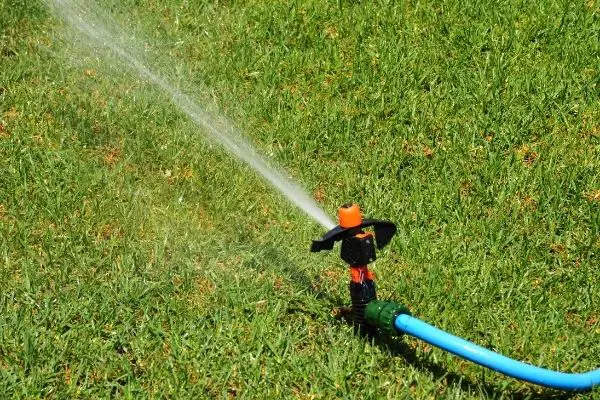
Do you know how much water goes toward keeping lawns alive every single day? Or where the fertilizer, pesticide, and other chemicals you apply each year really end up?
Once you learn the answers to these questions (and more) you’ll wonder why you ever wanted a grass lawn in the first place!
Water Consumption
Irrigation is a must in areas where rainfall is scarce. Even people living in temperate climates tend to rely on manual watering to keep their grass lawns looking healthy and green.
According to the Environmental Protection Agency (EPA), the average United States household consumes 50 gallons of water per day just for lawn and garden irrigation. In dry climates, the average daily water consumption is even higher.
Added up across the nation, the United States uses 9 billion gallons of water per day for landscape irrigation.
While this number includes both residential and commercial properties, it is still quite alarming.
Biodiversity
Biodiversity refers to the number of different species of plants and animals living on Earth. We can also look at biodiversity on a much smaller scale, such as what type of wildlife is living in our lawns and gardens.
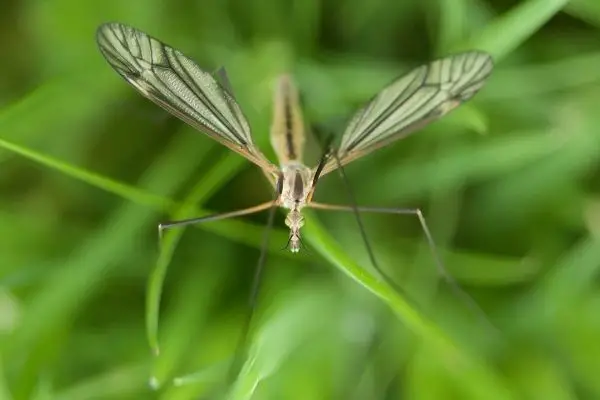
Grass lawns provide little in the way of habitat or food source for insects and animals.
While grass is better than nothing, the average lawn is a far cry from the kind of biodiversity you’d see in a natural meadow.
Covering a large area with grass can also leach the soil of key nutrients, particularly nitrogen. This increases the need for fertilizer (which comes with its own issues).
Chemical Use
To fully grasp the impact of lawn chemicals on the environment as a whole, it’s important to understand one thing — the effect of fertilizer, pesticides, and herbicides don’t stop at your grass.
These products can have unintended consequences both in your backyard and throughout the ecosystem.
Pesticides are notorious for affecting beneficial insects — including pollinators — as well as the bugs we actually want to target. Herbicides can impact native plant life around your property.
These chemicals can even enter the water supply, making their way to local streams, rivers, and lakes. Once there, fish and other aquatic wildlife can become ill or die due to contaminated water.
Fertilizer might seem harmless. After all, what could be wrong with adding nutrients to the soil? But these products are also at risk of harming the environment.
Like other lawn chemicals, chemical fertilizer is prone to entering nearby water systems. The increased nutrients allow algae to thrive, disturbing the natural balance and putting fish and other animals at risk.
Lawn Equipment
You can’t have a well-groomed yard without a lawnmower, leaf blower, weed whacker, and array of other power tools.
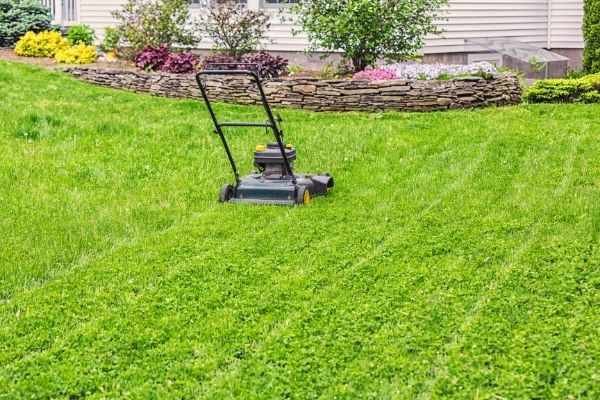
While most homeowners are concerned about the comfort and power of their lawn care arsenal, have you ever stopped to think about what this equipment could be releasing into the atmosphere?
Just like passenger vehicles, operating gas-powered lawn equipment creates harmful emissions.
According to the EPA, lawnmowers produce 5% of the United States’ air pollution. The EPA estimates that one gas-powered lawnmower produces the same number of emissions as driving eleven cars.
If that wasn’t bad enough, research also shows that over 17 million gallons of fuel are spilled when filling lawn equipment each year.
8 Eco-Friendly Alternatives To A Grass Lawn
Yes, you can have a lawn without grass! And it’s probably not as big of a sacrifice as you think.
Swapping out regular grass for eco-friendly species like ground cover plants or native perennials can make your lawn more sustainable and easier to maintain.
These are just a few of our eco-friendly lawn alternatives that will work in almost any climate:
1. Clover

Clover may be seen as a weed in the context of the traditional grass lawn. But this ground cover plant is one of the best eco-friendly alternatives for your backyard.
Clover grows low to the ground and can tolerate all types of sun and weather conditions. It’s also extremely drought-tolerant.
Compared to normal grass, clover offers a much better resource for pollinators and native wildlife. The clover flowers can be left to bloom or mowed down for a lush green appearance.
Before planting your own clover lawn, remember that there are several hundred species to choose from. For the most sustainable grass alternative, look for a species native to your area. Prairie clover is an excellent choice for much of the United States.
You can also mix clover seed with regular grass for a more eco-friendly lawn that doesn’t require additional fertilization thanks to the clover’s ability to add nitrogen to the soil.
2. Moss
If you want a green, eco-friendly lawn that doesn’t require mowing, moss might be your best bet.
One of moss’s greatest strengths is its ability to grow in areas where grass won’t. Moss thrives in dense shade and in acidic soil.
While moss is an excellent choice for many eco-friendly lawns, it is not a jack-of-all-trades.
Avoid planting moss if your lawn gets a lot of direct sunlight or you live in an arid climate. Moss requires plenty of moisture to survive, so you may want to invest in a rain barrel or another sustainable irrigation solution.
Another thing to consider is that moss has very shallow roots. It’s not the best option for high-traffic areas and won’t hold soil in place as well as traditional grass.
3. Native Grass
You might think any type of grass lawn is automatically unsustainable. However, there are plenty of grass species that grow native to various climates around the world.
Planting grass native to your region can cut down on the number of chemicals and water needed to keep your lawn happy and healthy.
There are many different types of native grass to choose from, so the more you know about your region’s climate and soil the better. Popular examples include:

4. Creeping Thyme
No, we’re not talking about the thyme found in your kitchen’s spice rack. Creeping thyme is an excellent alternative to traditional grass.
This plant stays low to the ground and spreads out nicely. It requires very little in terms of irrigation and is hardy throughout the United States and similar climates.
Despite its delicate appearance (especially when creeping thyme’s lavender-colored blooms are in season), this grass alternative is remarkably resilient against even heavy foot traffic.
Using thyme to replace a grass lawn is an excellent solution for small spaces. Unfortunately, thyme isn’t as easy to sow as grass seed and can take a bit of time to establish.
Many homeowners have success mixing thyme in with another ground cover or grass variety. You can also use creeping thyme as filler between paving stones or garden beds!
5. Native Perennials
It’s becoming more and more common for homeowners to forego a grass lawn altogether.
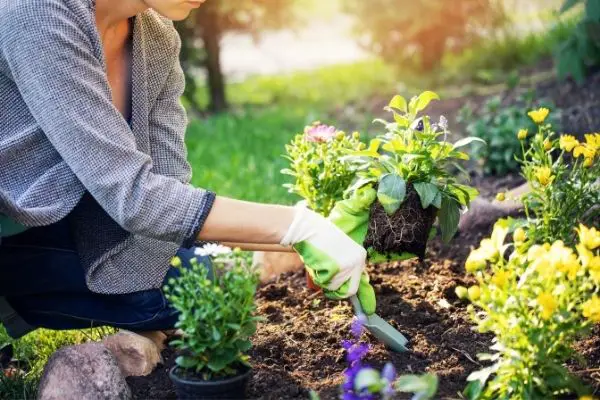
If having a wide-open lawn isn’t a top priority for your household, consider turning your entire yard into a garden bed. You can plant perennial species that bloom or choose evergreen cultivars for a low-maintenance landscape that looks great all year.
In more arid climates, homeowners can replace their ground cover lawns with drought-resistant plantings like succulents and cacti. If you’re looking for desert-friendly landscaping ideas, we recommend checking out the technique called xeriscaping.
Not only are native perennials built for your exact climate. They also fit right in with the existing natural ecosystem, including providing a food source and habitat for pollinators.
6. Sedum
Sedum (also known as stonecrop) are perennial succulents that thrive in a wide range of climates — even those where winter temperatures drop below freezing.
While many gardeners are familiar with tall varieties of sedum, this group of succulents can also be used as a ground cover. There are many species to choose from, all with different coloring, growth habits, and hardiness levels.
Keep in mind that sedum can easily replicate the look of grass but does not have the texture of a normal lawn. It won’t hold up to being stepped on or otherwise disturbed.
Plant low-growing sedum in areas without much traffic or as filler between other landscaping elements.
7. Corsican Mint
Corsican mint is a prime choice for anyone who enjoys the look of moss but wants to plant something a bit more resilient. And, yes, the foliage does give off a slight peppermint aroma!

Corsican mint produces small, compact leaves that grow no more than four inches from the ground. The plant also shoots out tiny white flowers throughout summer (which can be mowed down if you prefer).
This ground cover plant is ideal for shady spots and makes a great filler in both high- and low-traffic areas.
While you may need to fertilize your Corsican mint in spring to get the best results, it can adapt to many types of soil. It also spreads very easily once established, making for an easy installation.
Speaking of which, Corsican mint is considered mildly invasive. Avoid planting it if you live near an area at high risk of invasive species (such as a wetland, wildlife reserve, or native prairie).
8. Creeping Jenny
Few ground cover plants grow faster than creeping jenny (NOT to be mistaken for creeping charlie).
This plant, also known as moneywort, spreads quickly via stems of yellow-green leaves. It also produces vibrant yellow flowers throughout the warmer months.
Creeping jenny is quite popular as an ornamental landscaping plant. If you’re an experienced gardener, you may even be familiar with its reputation for taking over garden beds.
As an eco-friendly grass replacement, creeping jenny’s quick-spreading nature is actually an asset. It will quickly cover your lawn and can be kept under control by trimming back the edges.
With that said, you should only plant creeping jenny if you’re confident in your ability to keep its invasive tendencies in check.
Is Artificial Turf An Eco-Friendly Grass Alternative?

In many areas, artificial turf has been touted as a sustainable lawn replacement. This is especially the case in arid climates like the American Southwest.
While artificial turf does offer some advantages over real grass, it’s far from the epitome of sustainability.
How Does Artificial Grass Impact The Environment?
What Is Fake Grass Made Of?
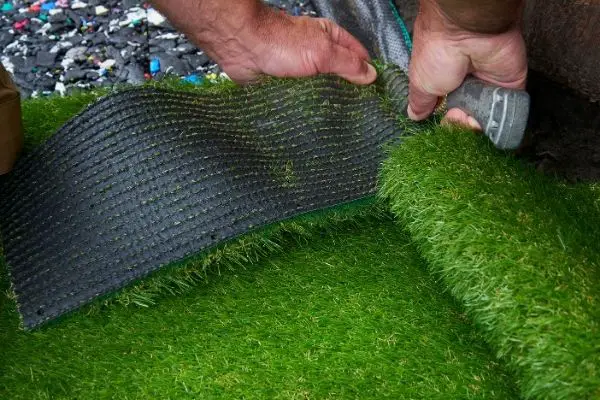
The simple answer is that artificial grass is made of plastic. But, as many eco-conscious consumers already know, not all plastics are created equal.
The most common materials used to make artificial grass blades are polyethylene and nylon. On its own, polyethylene is relatively easy to recycle. Nylon is not.
For the thatch and thatch backing (the layer that holds all of the blades in place), most artificial turf manufacturers use polypropylene and polyester.
Polyester foam and rubber are frequently used to cushion the artificial turf, making it more comfortable to walk on.
Can Artificial Turf Be Recycled?
Most of the materials used to make artificial grass can be recycled on their own. However, the process is complicated by the fact that so many different plastic and non-plastic compounds are used to construct one product.
Because it is difficult or impossible to separate all of these different materials, very few companies will attempt to recycle artificial turf.
Fortunately, the technology used to recycle artificial turf and similar items is improving. For now, though, it’s much easier to repurpose old turf than to recycle it.
For example, many playgrounds, animal shelters, dog parks, and recreational centers have found ways to reuse discarded artificial turf and prolong its lifespan.
While not a perfect solution, this helps keep plastic turf out of landfills for at least a little bit longer.
How Much Is An Artificial Lawn?

Artificial turf comes with a big upfront cost.
While most artificial lawn installations end up breaking even over the course of the turf’s lifespan, spending such a large amount on a sustainable grass alternative isn’t always possible.
High-quality nylon grass can cost between $5 and $20 per square foot. The “standard” installation covers around 500 square feet and costs between $2,500 and $10,000.
Keep in mind that 500 square feet is much smaller than the average lawn.
Lawn size varies greatly based on factors like neighborhood, geographical location, and property type. In the United States, the average lawn size is 10,871 square feet (or a quarter acre).
So for a typical American lawn, you can expect to pay over $50,000 to completely replace your real grass with premium artificial turf.
How Do I Make My Lawn Grass-Free?
Unless you’re starting with a brand new property, there’s a good chance you’ll need to remove your existing lawn before installing a sustainable alternative.
Here are the top methods for removing established grass from your property so you can start fresh:
Herbicide
Some homeowners choose to use chemical herbicides for grass removal. However, this method isn’t always effective and there is quite a bit of room for error.
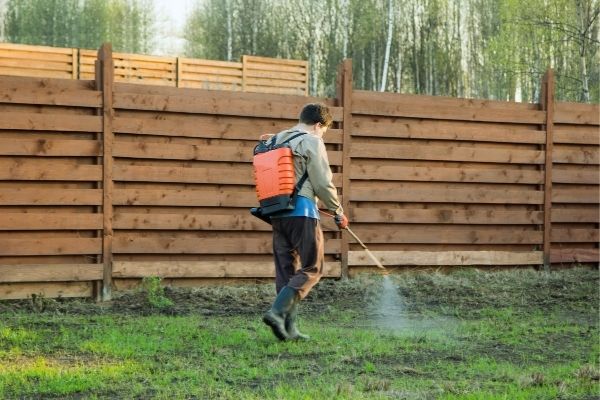
You’ll want to avoid applying herbicide before rain, which will wash the chemicals away and introduce them to the groundwater supply. You also must be careful to only apply herbicide where you want to remove grass — other plants may be affected as well.
If you do opt for herbicidal removal, we strongly recommend hiring a professional to ensure things are done in the safest and most eco-friendly way!
Solar Power
No, you’re not going to use solar energy to remove your existing turf — at least not in the way you’re imagining.
Solarization is a process that uses plastic to smother the plants and soil below. On top of preventing the grass from completing photosynthesis, the plastic traps heat underneath to “cook” the grass until it dies off.
This method is very effective but keep in mind that it can take up to two months to see full results.
Digging
Digging might be the most labor-intensive grass-removal method. It’s also the most straightforward.

The best technique for removing large areas of lawn is to cut the turf into one- or two-foot strips. Fine Gardening recommends using a spade or edging tool for this step.
You can then lift one end of a strip and use a sharp tool to cut through the soil and roots underneath. Continue working down the strip until it is completely lifting, rolling as you go.
Since this process removes a good bit of topsoil and organic matter from your lawn, it’s not ideal if you want to replant the area immediately after. The remaining soil will need to be supplemented with compost before planting.
Smothering
Smothering a grass lawn is very similar to solarization but many people view it as more environmentally friendly than the latter method. It’s also a great alternative if you live in an area with unreliable sunlight.
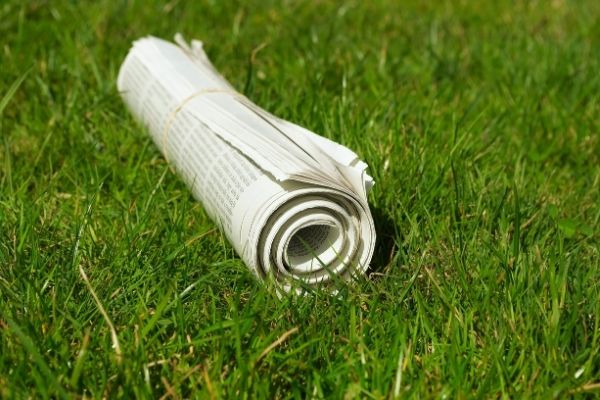
For this method, you’ll need a hefty supply of old newspaper (avoid pages with color ink) or unprinted cardboard.
Cover the grass with a thick layer of your chosen material. While a single layer of cardboard will suffice, Lowe’s recommends using around six pieces of newspaper. Water the covering and add plant matter — grass cuttings, leaves, etc. — over the top.
This method blocks photosynthesis and reincorporates the grass into the soil like compost. Again, it will take up to two months to see results, and the grass must remain covered the entire time.
Frequently Asked Questions
Does cutting grass release CO2?
Yes, grass lawns do release carbon dioxide (CO2) when they are cut.
If biology class taught us anything, it’s that plants take in carbon dioxide and release oxygen throughout their entire lives. What many of us didn’t learn, however, is that all of that stored carbon dioxide returns to the environment when a plant is cut or dies.
When it comes to grass, the uptake and release of carbon dioxide occur in a continuous cycle as people mow their lawns.
While mowing the lawn won’t necessarily release more carbon dioxide into the atmosphere than your grass has absorbed. But this does mean that lawns are not the great air filtration systems that many people believe.
At best, grass lawns are net neutral.
How do I know which grass alternatives are safe for dogs?
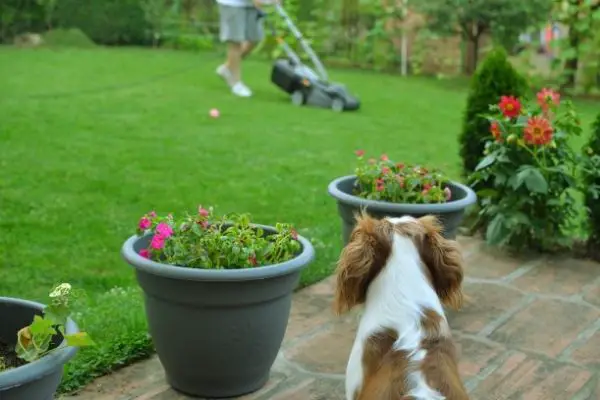
Clover, creeping thyme, sedum, and pachysandra are all dog-friendly options for a grass-free lawn. However, there may be other options (including native varieties) that we didn’t get a chance to mention.
If you’re looking for a sustainable alternative to a grass lawn that won’t harm Spot or Fido, the American Society for the Prevention of Cruelty to Animals (ASPCA) is an amazing resource. The ASPCA maintains a list of plants that are toxic to dogs, cats, and horses.
Can my dog go to the bathroom on artificial grass?
Yes, dogs can do their business on artificial turf without harming themselves or ruining the material.
Just keep in mind that artificial turf won’t break down dog waste like real grass. So you’ll need to regularly pick up after your dog to maintain a clean lawn (which you should be doing even with a grass or ground cover lawn!).
Dog urine will drain through artificial turf to the ground below. Spray down potty areas regularly to wash away residue and fight odor.
Last update on 2024-04-09 / Affiliate links / Images from Amazon Product Advertising API

